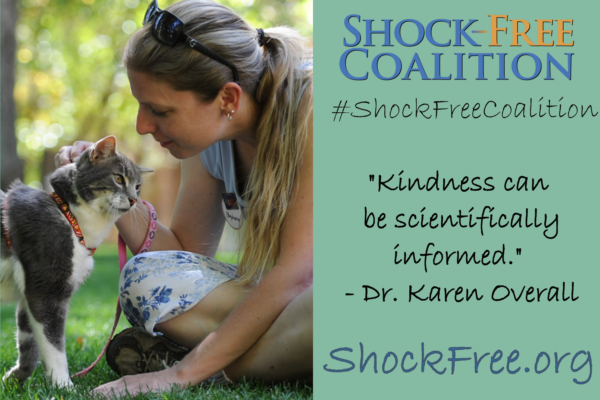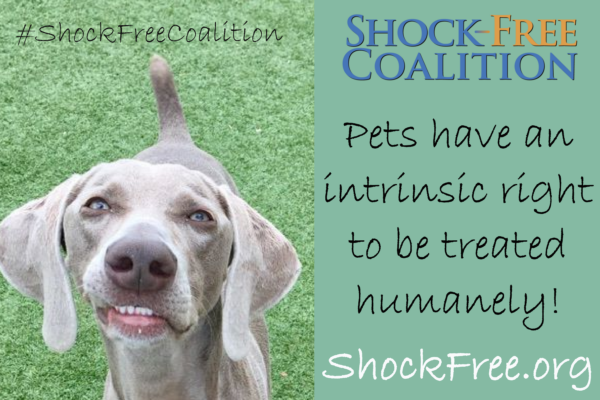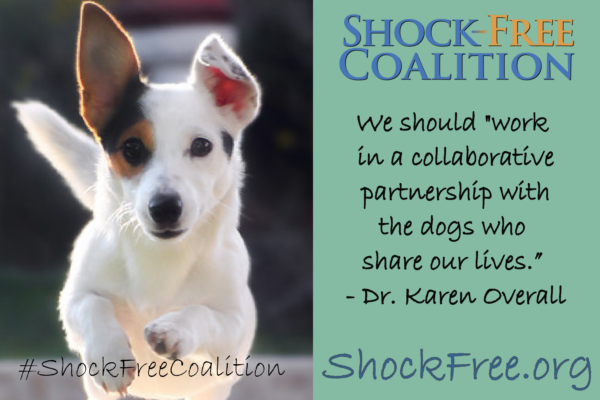Learning Theory
The Unintended Consequences of Shock
(Confidentiality Notice: Names in this blog have been changed to protect privacy, but the facts remain unchanged. Photographs have been used with written consent.) Betsy is a kind person who contacted a shelter in June of 2016 to help find a nice family dog to share her life with through adoption. She learned of Zelda, a female one year old mixed breed. Zelda’s online biography suggested she was “fine” with other dogs and was “friendly” with people, but jumped on them “to say hello.” Little was known about Zelda except… Continued
Clicker Training for Cats (6/6)
By Paula Garber and Francine Miller Inter-Cat Aggression Living with cats who do not get along is stressful for everyone. Sometimes the cats need to be completely separated and then formally re-introduced. In many cases, the best outcome we can hope for is for the cats to coexist peacefully to a point where they tolerate each other, even if they do not actively “like” each other. To facilitate peaceful coexistence, the environment must be arranged so that the cats can easily avoid each other and do not have to compete… Continued
Mama Dogs Don’t Use Treats…..
By Yvette Van Veen Many people seem enamoured with the idea that we should emulate what dogs do in the wild. “Mama dogs don’t give treats in the wild,” is one of the more common expressions. This one carries quite a punch. People have a natural affinity for natural. Expressions, analogies, metaphors and idioms can serve various purposes. They can help explain, illustrate and educate. At their best, they simplify a complex topic. They are also used to influence and to persuade. The “mama dog” line usually falls into the… Continued

The Pet Professional Guild Position Statement on the Use of Shock in Animal Training
It is Pet Professional Guild’s (PPG) view that electric shock in the guise of training constitutes a form of abuse towards pets, and, given that there are highly effective, positive training alternatives, should no longer be a part of the current pet industry culture of accepted practices, tools or philosophies. In this position statement, PPG will combine decades of research with the opinions of certified animal behaviorists, and highlight the question of ethics to explain why using electric shock in the name of training and care is both ineffective and… Continued
Clicker Training for Cats (5/6)
By Paula Garber and Francine Miller Introducing Cats to Each Other In a nutshell, cats should be gradually introduced to each other one sense at a time: first by scent, then by sight, and then physically. Throughout the process, positive associations are built up with the scent, sight, and physical presence of the other cat using food, play, brushing, low-key play—anything the cats enjoy. When introducing cats, you can use clicker training to help boost positive associations between them and keep them focused on you instead of each other. During… Continued
The Neurological Benefits of Counter Conditioning Leash Reactive Dogs
Creating new and better associations for dogs on leash when exposed to fearful/stressful stimuli is crucial, as it is better for all involved for the dog to be less stressed and less fearful. The goal is potentially a positive association is created, or at least less stress. When this can be achieved via counter conditioning and desensitizing dogs to these intrinsic stimuli, and many times they can be, then life is better for the humans and the dogs that have stress when on leash. This is something that, among dog… Continued
Higher-Order Conditioning: Did it Happen To My Dog?
The other day I was sitting in my bedroom with Clara and Zani and the doorbell rang. And there was dead silence. This pierced my heart. If you follow the blog, you know that I lost my dear dog Summer suddenly in August. She was wonderful beyond compare. She also barked reactively at delivery trucks, the mail carrier, anyone but me on the porch, and the doorbell. So for me, this silence was one of those dozens of daily moments where my heart ached. There was a hole where… Continued

The Science of Force-Free Learning: How Our Pets Learn!
Introduction Here at the Pet Professional Guild (PPG), we like to focus on building relationships with our pets by using positive reinforcement to train new skills, and to build new behaviors as replacements for problematic ones. Because the emotional brain inhibits the rational brain (and vice versa), nobody, and that includes our pets, can learn something constructive and pleasant when in a fearful or anxious state. Positive reinforcement means giving an animal access to something he desires (e.g. food or a toy), which makes it more likely he will repeat the behavior that… Continued
Clicker Training for Cats (4/6)
By Paula Garber and Francine Miller Clicker Training for Behavioral Problems: Clawing Furniture/Destructive Furniture Scratching Destructive furniture scratching is a commonly reported problem in cats, and one of the many unwanted behaviors that clicker training can help. Without going into all the reasons cats scratch (for more details on scratching, see Scratch Here, Not There, BARKS from the Guild, July 2016, pp. 25-26), it is suffice to say that cats have to scratch. It is a natural behavior that serves many purposes. Having said that, cats can certainly be taught… Continued
An Open Letter to Veterinarians on Referrals to Training and Behavior Professionals: Recommended Best Practices
Dear Veterinarian, There are numerous professional organizations that offer membership and credentials in the field of animal training and behavior. Few, however, hold their members to a strict code of conduct which involves the application of their trade through scientific protocols and the objective to cause no harm. Unfortunately, the pet training industry is entirely unregulated, meaning that anyone can say they are a trainer or behavior consultant. As a result, those who call themselves dog trainers, or even “dog whisperers,” may still be utilizing punitive methods, such as disc… Continued
Clicker Training for Cats (3/6)
By Paula Garber and Francine Miller Cats learn best when they are comfortable and free from distractions. They are sensitive and will flee from any threat or uncertainty (and we don’t work with them on a leash!) The best place to teach a cat is somewhere he finds quiet and familiar. This may be challenging because with their acute senses of smell and hearing they may be distracted by things we are unaware of. You should train in a place with a litter box available, fresh water and a place… Continued

An Open Letter To Pet Retailers Concerning The Availability of Pet Training and Management Devices That Deliver Electric Shock
In September 2017, the Pet Professional Guild (PPG) rolled out its Shock-Free Coalition, the key purpose of which is to build a strong and broad movement committed to eliminating electric shock devices from the worldwide supply and demand chain. It is our intent to fully realize the goal of shock tools and equipment being universally unavailable and no longer permitted in the training, management and care of pets anywhere. We plan to work diligently to achieve the following: 1. To engage and educate pet owners and shelter/rescue workers to help… Continued
Clicker Training for Cats (2/6)
By Paula Garber and Francine Miller In clicker training, primary reinforcers are things that are instinctively or inherently rewarding to a cat. Reinforcers for cats should be given in small amounts and frequently to maintain learning momentum. For cats who are food motivated, use high-value food or treats for clicker training. Many cats like foods with a high animal protein content, like cooked or freeze-dried meat or fish. Other foods to try include canned tuna, deli meat, meat-based baby food (make sure it doesn’t contain onions), and liver paste made… Continued
Counterconditioning Leash Reactivity, the Hybrid Approach
Leash reactivity towards dogs, humans or traffic, is one of the most challenging training endeavors. This is simply because there is no consistency in the appearance of the stimuli, and there will most assuredly be at some point, an over threshold event for the dog due to “criteria pile up”. More than one piece of criteria at a time combined with a lack of sufficient distance, too much duration, and or both, then add in the stimulus entering the environment with intensity of both the visual and auditory components known… Continued
Are You SURE Your Dog Prefers That Food Toy?
It just occurred to me that it is super easy to make assumptions about how much our dogs prefer a particular food toy, or even whether they really enjoy them that much. Don’t yell at me. To be clear: I use food toys for my dogs every single day. I think they can be enriching and that they are ethical things to use. But food toys present us with a funny little problem. The laws of behavior get in the way of something we might like to know. How can we tell… Continued

An Open Letter to Pet Industry Representatives Regarding the Use of Shock in Animal Training, Management and Care: We now know enough to stop shocking our pets
Shocking pet dogs remains a common, if controversial, training practice worldwide. In this open letter, Pet Professional Guild (PPG) combines decades of research, the opinions of certified animal behaviorists, and the question of ethics to explain why using electric shock in the name of training and care is both ineffective and harmful. PPG concludes that shocking constitutes a form of abuse towards pets, and, given that there are highly effective, positive training alternatives, should no longer be a part of the current pet industry culture of accepted practices, tools or… Continued
Clicker Training for Cats (1/6)
By Paula Garber and Francine Miller Why train a cat? Why indeed. Myths about the trainability of cats abound: “Cats can’t be trained because they’re too independent.” “Cats are difficult to train because they are not food motivated.” “Cats don’t need training like dogs do.” These are all common misconceptions, but get ready to kick all the myths to the curb and add some useful cat training tools and techniques to your repertoire. Clicker Training Professional dog trainers will already know all about clicker training and many use the method… Continued

Why do food rewards win, but not for separation anxiety?
By Julie Naismith Rewards-based training is the best. Dogs love it because it’s fun and it doesn’t involve fear or pain. And best of all, it works. In fact, research shows that it works better than any other method. Hands down, the best tool for training is food. But, despite the fabulousness of food, it’s best left in the cupboard when we’re training a dog with separation anxiety. It’s not that we couldn’t use food for separation anxiety training, it’s just that we don’t need to. When it comes to… Continued

An Open Letter to County Commissioners re: Consumer Transparency – the Methods Used in Animal Training, Care and Management Will Protect Pets, Their Owners, Local Residents and the Public at Large
By Susan Nilson and Niki Tudge Introduction: The Importance of Transparency between Clients and Service Providers Frieden (2013) states that: “Free and open information empowers people to make informed choices and reduces the likelihood that misinformation or hidden information will endanger health.” It is not unusual and, in many cases, is mandated, that providers and manufacturers of potentially dangerous services and products place warnings on said products, thus providing transparent details to the end user regarding any risk from use. Tobacco, alcohol, gardening equipment, power tools, and even some children’s toys… Continued
An Open Letter To Pet Owners About The Pet Professional Guild’s Shock-Free Coalition
According to the American Pet Products Association (2017), 68 percent of Americans return home to a pet (or pets) each day. An estimated 48 percent of US residents are dog owners while 38 percent share their home with a cat (or cats). In spite of this, for many people, more time is spent planning the family vacation than on bringing a pet into the home. Compounded by the fact that many of us not only work full time and raise children, we are also swamped with family commitments and countless… Continued
Just Say No to Saying “NO!”
It’s almost a reflex. There goes Rover, in hot pursuit of the cat, or gnawing on the sofa, or slurping at your dinner plate, or barking threats at squirrels…and we just need it to STOP, so we shout “NO!” Then one of several things happens: The behavior pauses for a split second, then resumes. Or, if you have a “soft” dog whose feelings are easily bruised, he’ll hang his head and beg for forgiveness–knowing you’re displeased but not necessarily knowing why. An independent and tenacious dog like mine will assume… Continued
Ping Pong Recalls
When I ask new puppy owners ‘what are the most important objectives for you and your new pup?’ you can bet that right at the very top of that list is ‘I want to be able to let my dog off lead and for her to come back when called!’ I think that’s pretty reasonable – most of us have at some time experienced those palpitations when you’re calling and calling AND calling and there’s no response – isn’t that the best relief when that little head pops up? So, what… Continued
Using Annoying or Scary Sounds for Dog Training
Let’s pretend you saw an ad for a new dog training product. It read something like this: Introducing the Noise-Aided Obedience Device (NOD)! Never have trouble with your dog again. When you jerk or flap the lead attached to your dog’s collar or harness to punish him or to force him into the correct position, the device adds a noise that makes the leash jerking or flapping extra unpleasant. You can get instant compliance! That is, for some dogs. Some won’t be bothered by the noise or will get used… Continued
Front Door Freakout
If you come to my house, brace yourself. You walk up the stairs, ring the doorbell. Suddenly…the shrieking of a hundred banshees? Maybe an exorcism in progress? Or fiery-eyed, froth-mawed Cerberus guarding the gates of Hades? Nope. It’s my people-loving hound Huckleberry going freakshow crazy at the front door. Sometimes trainers’ own dogs can make people doubt our training chops. Maybe it’s that we fall in love with “project” dogs, with issues so bedeviling we’re sure no one else will put up with them. We bring home these fixer-upper pups, and… Continued
« Previous 1 2 3 4 … 6 Next »

